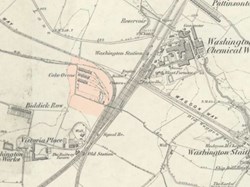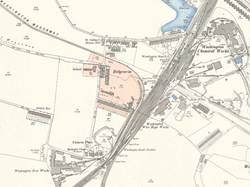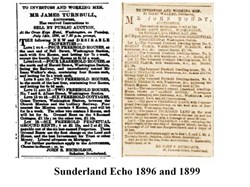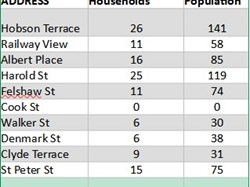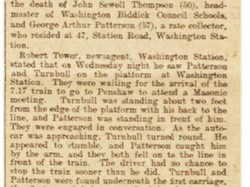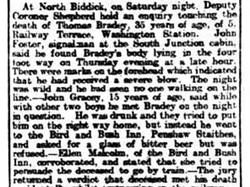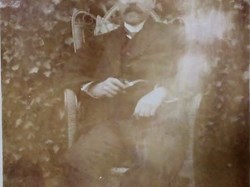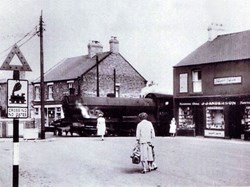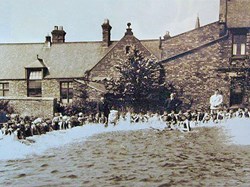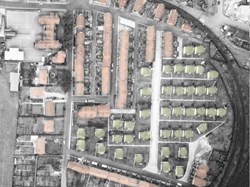Belgravia Washington
Industry
For a very short time a neighbourhood of Washington Station was called Belgravia. The site was in that part of the area that developed rapidly in the 1840s with the construction of the North Eastern Railway running north to south, the opening of the Washington Iron Works by Joseph Cook and the Washington Chemical Works by Hugh Lee Pattinson, and a complex of sidings connecting the works to the rail line. Indeed these two industrialists were very influential in determining the route of the line.
The line ran across the much older Oxclose and Washington wagon ways, used to deliver coal from the respective pits to the staithes on the River Wear. When they were upgraded to carry stream trains they were redirected south to link with the main line, with in turn had new connections to the staithes. Coke ovens were built in the arc of the wagon ways where they turned for the main line, and they also had rail connections. The first Ordnance Survey map of 1857 shows all these workings; the Iron Works and ovens, the Chemical Works, the Washington Staithes, the main rail line and how they were all connected by rail tracks.
Homes
However, though the iron and chemicals works were considerably larger, by the 1880s the ovens were redundant. Oxclose pit also closed and the rails were lifted from that part of the wagon way. In the following years Mill Lane that connected Washington Village with the railway station was upgraded and renamed Station Road, and a series of residential terraces built either site of it’s course. About this time the whole of the area up to Glebe Colliery became known as Washington Station. Included among the terraces were houses on the coke oven site, plus Biddick Mixed Junior School built in 1892, followed by a Wesleyan Methodist chapel and church hall, and a territorial drill hall. The first houses were built at the south of the site; Hobson’s Terrace and Railway View.
The landowner and developer was Isaac Walker, owner of the Washington Wire Works (later Newall’s Wire Works), on the other side of the main line, next to the chemical works, and the owner of a provisions store in Albert Terrace, where he lived. It’s very likely it is he who named the development Belgravia, though it only appeared once on the 1895 OS map.
Eventually by 1911 there were 120 dwellings in 10 streets, home to 125 households and 651 people. They came from all parts of County Durham as well as the rest of Washington, attracted by the chemical and iron works, the railway companies, and local pits; Glebe Pit at the other end of Station Rd opened in 1904. Over half the site was left open including a large stretch south of the school spilt between a playing field and allotments.
Tragedies
In 1906 thirty five year old local storekeeper, Thomas Bradey was killed walking home, late at night, from Penshaw. The coroner’s reported indicated he had been drunk and had walked over the Victoria Viaduct. He was struck by a train near the iron works. He left a wife, Frances, and 5 year old son, Wilfred. He in turned drowned in the River Wear in 1911 aged 16. His mother, Frances, committed suicide in 1920. In probate records the three of them are recorded as having lived in Albert Place. It is believed that- though the spelling is slightly different- that this how Brady Square got it’s name, and indeed that name emerged in the 1930s on maps and bus routes.
In December 1914 the boys headmaster of Biddick School, John Sewell Turnbull aged 50, and travelling companion, George Arthur Patterson aged 47, were struck and killed by a train when they fell off the platform at Washington Station. John lived in the school house with his wife, Margaret Bell Turnbull, the headmistress at the school for the girls. She moved out to a house in Station Road and died 5 years later. This tragedy shocked the neighbourhood. John Turnbull was remembered as a caring head teacher, who, in the mornings and afternoons would oversee children crossing the active wagon way.
The impact of World War One
The Wessington U3A War Memorials Project has tracked the service of Washington men who fought in World War One, and listed the 400 who died. It is known that at least 60 men with a connection with the Belgravia joined the Army and Navy between 1914 and 1918. It was the registered home of some, or their parents, or they had lived there in 1911. At least 19 were killed or died of wounds. These included 26 year old 2nd Lieutenant James Francis Gordon Ashworth. He was from Barrow in Furness, but had been a teacher at the school before moving to Glasgow after marriage. The most lethal day was the first day of the Battle of the Somme, 1 July 1916, when 4 men from the neighbourhood lost their lives.
Other causalities included brothers Robert and Thomas Jefferson of Harold St, and brothers Charles Hall Smith and George Brabben Smith of Hobson Terrace within two weeks of each other. Frederick Armstrong, the maternal grandfather of Washington Station’s most famous son, singer and musician Bryan Ferry, was killed in 1918, leaving his wife Ethel and three children.

Fred Hill
One of Washington’s most prominent residents, Fred Hill, became the headmaster of Biddick School in 1926. He was a passionate local historian, and the driving force that pulled together the Washington Old Hall Preservation Committee in the 1930s, that saved the Hall from demolition and oversaw its restoration in the 1950s. He prompted the pupils of the school to celebrate the connection with George Washington by becoming pen pals with American children, observing the 4th July anniversary, and hosting American visitors. He himself undertook a fund raising tour of the USA before the war.
In 1931, fed up with the local authority's reluctance to provide a swimming pool, he organised the digging of one in the garden of the school. It was opened six weeks later, and was very popular, though it closed just five years in 1936.
The Post War Years
In the late 1940s the remaining open space was filled with 39 pre-fabricated bungalows- prefabs- which were demolished by the New Town Development Corporation in the late 1960s. About the same time the Washington Station area was renamed Columbia, and the school became Columbia School.
The F Pit closed in 1968 and the rails lifted soon after by the Development Corporation. This removed what had been the boundary of the neighbourhood. The route still remains as a straight path through the housing that was built in the 1970s on either side of the line.
The top half of the allotments were built on as an extension of Albert Place with a series of detached bungalows. However the most dramatic change was the cutting of the A195 Eastern Highway diagonally north east to south west though the site of all the terraces east of the school, and the remaining allotments. The area east of the new road became the Swan Industrial Estate. The school closed in the late 1980s and for a number of years was the Washington Church of Christ. In 2003 the brand new Columbia Grange School opened on what had been the playing fields south of the school.
In 2023 Sunderland City Council extended and converted the school into a series of apartments for adults with physical challenges, and built a number of adapted bungalows on the other side of Albert Place. There is now a blue plaque honouring Fred Hill on the wall of the apartments.
This is just the story of one small neighbourhood in Washington that has continued to be redeveloped over the last 150 years. Most of it’s triumphs and tragedies are long forgotten, but then there are parallels in the rest of the town as it has evolved over the decades. The History Society would be interested in learning about other residents of this area. Contact us at washingtonhistorysoc@gmail.com
